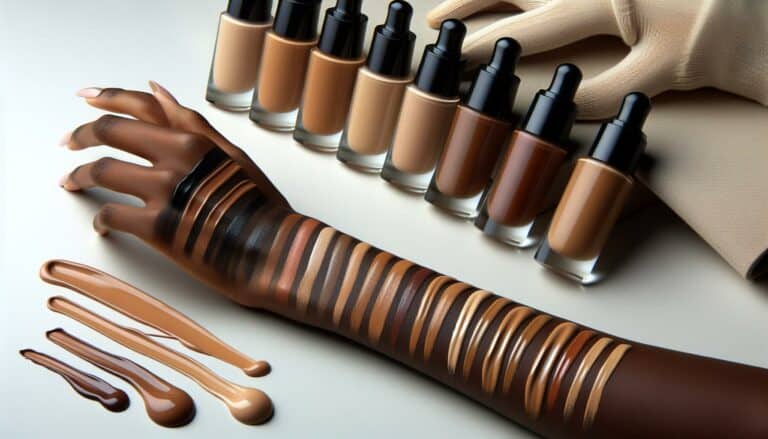Easy Guide: How to Make Your Foundation Darker & Blend It Perfectly
Why is getting the right foundation shade important?
Finding your perfect foundation shade is akin to discovering the Holy Grail of makeup. It’s the cornerstone of a flawless makeup look, making or breaking your entire aesthetic. The right shade doesn’t just blend seamlessly with your skin tone; it enhances your natural beauty, ensuring that your look is as authentic and vibrant on the outside as you feel on the inside.
When your foundation shade is a perfect match, it eliminates common issues like ashiness, unnatural contrasts, and the dreaded mask effect where your face and neck don’t match. These issues can distract from your overall appearance, drawing attention away from your intended makeup artistry.
Here’s a simple breakdown of why matching your foundation shade is crucial:
| Reason | Impact |
|---|---|
| Seamless blending | Creates a natural, flawless finish |
| True to your natural skin tone | Enhances rather than masks your beauty |
| Prevents makeup lines | Eliminates harsh lines between the face and neck |
| Boosts confidence | Makes you feel more comfortable and confident in your skin |
“Makeup is not a mask that covers up your beauty; it’s a weapon that helps you express who you are from the inside.” – Michelle Phan
Incorporating the right foundation shade into your makeup routine is more than just a step towards a stunning look; it’s an act of self-care. It says that you value your unique beauty and are committed to showcasing it in the most authentic way possible. Additionally, with the advancements in makeup formulation and the variety of shades available, finding your perfect match has never been easier.
Assessing your foundation shade and skin undertone

Before you jump into making your foundation darker, it’s crucial to assess your current foundation shade and, more importantly, your skin’s undertone. Understanding these will guide you in choosing the right product to darken your foundation without altering its true tone.
Skin undertones are categorized into three types:
- Cool (pink, red, or bluish undertones)
- Warm (yellow, peachy, golden undertones)
- Neutral (a mix of warm and cool undertones)
| Undertone | Characteristics |
|---|---|
| Cool | Pink, red, or bluish hues |
| Warm | Yellow, peachy, golden hues |
| Neutral | A mix of warm and cool hues |
To determine your skin’s undertone, look at the veins on your wrist in natural light. If they appear blue or purple, you’re likely cool-toned. If they look green, you have a warm undertone. Can’t decide? You’re probably neutral.
Remember: The goal is to enhance your natural complexion, not change it.
Once you’ve got a handle on your undertone, assess your current foundation shade. If it’s too light or if your skin tone has deepened, you’ll need to darken it. However, avoid making dramatic changes that don’t align with your natural undertone.
By understanding these elements, you’re well-equipped to make informed decisions on how to adjust your foundation shade. Remember, the key is to achieve a seamless match, enhancing your natural beauty. Keep these points in mind as you explore options for darkening your foundation.
Method 1: Mixing in a darker foundation
If you’ve found yourself with a foundation that’s a shade or two too light, don’t worry. You’re not alone, and there’s a straightforward solution at hand. Mixing in a darker foundation can quickly adjust the shade to better match your skin tone. Here’s how you can do it effectively.
First, you’ll need to select a darker foundation. It’s crucial that this foundation has the same formula (liquid with liquid, powder with powder) as your lighter one to ensure a seamless blend. Mixing different formulas can lead to a patchy application.
Once you have your darker foundation, the mixing process is quite simple:
- Start with a 1:1 ratio of your lighter foundation to the darker foundation on a clean mixing palette.
- Use a foundation brush or a mixing tool to blend the two shades together thoroughly.
- Test the mix on your jawline to see if it matches your skin tone. If not, adjust the ratio accordingly.
Here’s a quick reference table for mixing ratios:
| Light Foundation | Dark Foundation | Resulting Shade |
|---|---|---|
| 1 part | 1 part | 1 shade darker |
| 1 part | 2 parts | 2 shades darker |
| 1 part | 3 parts | 3 shades darker |
Remember, it’s always easier to darken a light foundation than to lighten a dark one, so start with small amounts of the darker foundation and gradually increase until you reach your desired shade.
“A seamless foundation match enhances your natural beauty by blurring imperfections without masking your skin’s unique charm.”
By mastering the technique of mixing foundations, you gain control over your makeup, ensuring you always have the perfect shade no matter the season or occasion.
Method 2: Adding a darkening agent
When your foundation is a shade too light and mixing in a darker foundation isn’t an option, turn to a darkening agent. These specialized products are formulated to adjust the color of your makeup without altering its texture or finish.
Finding the right darkening agent can be a journey, but the key is to look for products that are compatible with your foundation’s base—whether it’s oil, silicone, or water-based. This ensures that your foundation’s integrity isn’t compromised.
To use a darkening agent, follow these simple steps:
- Start with a small amount of your foundation on a palette or a mixing surface.
- Add a tiny drop of the darkening agent to the foundation. Remember, it’s easier to darken a foundation gradually than to try and lighten it after adding too much darkening agent.
- Mix the foundation and darkening agent thoroughly until you achieve a uniform color.
- Test the adjusted shade on your jawline to ensure a perfect match with your skin tone.
Here’s a quick reference table to guide you through the process:
| Foundation Amount | Darkening Agent Drop(s) |
|---|---|
| 1 part | 1/8 part |
| 2 parts | 1/4 part |
| 3 parts | 3/8 part |
Key Takeaway: Less is more when it comes to adjusting foundation shades. It’s essential to start with small quantities of darkening agent and incrementally add more until you achieve your desired shade.
By mastering the skill of darkening your foundation with a darkening agent, you’ll ensure that your makeup always matches your skin tone perfectly, regardless of the season or changes in your complexion.
Method 3: Using bronzer or contour products
If your foundation is a shade too light, don’t worry! You’ve got another trick up your sleeve: bronzer or contour products. This method is simple and doubles up by adding definition to your face while adjusting the foundation color.
Bronzers and contour products come in various forms: powders, creams, and liquids. Choosing a format that aligns with your foundation’s base (water, silicone, or oil) is crucial for a seamless blend. If your foundation is water-based, stick to water-based bronzers to avoid any makeup mishaps.
Here’s a quick guide on how to integrate bronzer or contour products with your foundation:
- Start with a clean, primed face.
- Apply your foundation as you normally would.
- Take a small amount of your bronzer or contour product.
- For powders, use a fluffy brush to lightly dust and blend into areas where the sun naturally hits your face and along the jawline.
- For creams and liquids, dot the product in the same areas and blend with a damp makeup sponge.
- Build the color gradually, ensuring everything is well-blended to avoid any harsh lines.
Remember, the goal is to darken your foundation subtly and add warmth to your complexion. It’s easy to go overboard, so start light and build as needed.
| Product Type | Recommended Application Tool |
|---|---|
| Powder | Fluffy Brush |
| Cream | Makeup Sponge |
| Liquid | Damp Makeup Sponge |
Pro Tip: “Always blend upwards to lift the face and avoid dragging the skin down.”
Mastering this method can not only save you from the woes of a mismatched foundation but also enhances your natural bone structure. Give it a try and see how a little bronzer or contour can make a big difference.
Conclusion
Once you’ve darkened your foundation using bronzer, contour products, or a darker foundation shade, it’s essential to blend well for a natural finish. Here are some techniques and tips:
- Use a Beauty Sponge or a Stippling Brush: These tools help in blending the product seamlessly.
- Lighting Matters: Always check your makeup in natural light to ensure it looks natural and well-blended.
- Layer Wisely: If you’re using additional products like blush or highlighter, remember to layer them lightly to maintain the foundation’s adjusted shade.
Incorporating these techniques will enhance the overall look, ensuring your makeup appears flawless.
“Makeup is not a mask. It’s a form of art and, more importantly, a form of expression.” This quote resonates especially when adjusting foundation shades, as it’s all about expressing your true self comfortably.
Importance of Testing
It can’t be emphasized enough how crucial it is to test the foundation shade after adjustment on your jawline. Not only does this ensure compatibility with your skin tone, but it also confirms the product’s feel on your skin.
Here’s a brief overview of why testing is paramount:
| Aspect | Reason |
|---|---|
| Skin Tone Matching | Ensures the adjusted foundation matches your skin tone perfectly. |
| Feel on the Skin | Confirms if the foundation feels comfortable and is suitable for long wear. |
| Reaction with Light | Checks how the foundation appears under different lighting conditions. |
By paying attention to these details, you’re guaranteed a foundation that not only matches your skin tone perfectly but also feels comfortable and looks natural under any lighting.








